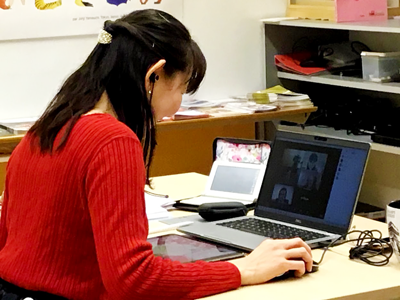2021 Japanese-Language Assistants’ Report: COVID-19 in France: Warmth felt through online contact
The Japan Cultural Institute in Paris
SUGIMOTO Sanae

View from the Institute
The Japan Cultural Institute in Paris (hereafter referred to as "the Institute"), where I have been posted since September 2020, is a modern building with all glass walls, and is blessed with a view of the Eiffel Tower right next to it and the Seine River in front. Since its opening in 1997, the Institute has been promoting the appeal of Japan to France through a variety of activities, including exhibitions, performances, films, cultural classes, and Japanese language programs.
The Japanese Language Department, to which I belong as a Japanese-Language Assistant (hereafter referred to as "Assistant"), conducts Japanese-Language Courses, training and teacher support related to Japanese language education, and also events for Japanese language learners. Since my arrival, unfortunately, due to the spread of COVID-19, most of our projects have not been implemented in the traditional way, but we are continuing to make the best use of online services and provide support in different ways. Now that six months have passed since I took up my new post, I would like to share with you what I feel about the shift to online Japanese language education in France.
Through teacher training
From the time I arrived in September until now (March 2021), the "Online Training Programs for Japanese-Language Teachers" has been held every month, and I have been in charge of the pre-training preparations and technical support during the program. This program is a continuation of a support course that started in March 2020, to help teachers in the field teach smoothly when, because of the lockdown, we suddenly switched to online classes. Since September, we have been introducing online tools to teachers living mainly in Europe, including France, and reporting on our work.
The participating teachers come from a variety of institutions, with many different types of students, but they all share the same passion for teaching and care for their students. I am inspired by the way they are always looking for ways to make online classes as easy to understand as face-to-face classes, and what tools to use in what situations to make them more effective. It also gives me a great opportunity to think about what I can do to teach better in class.
Through the teachers who participated in the program, we were able to get a small sense of what junior high schools, high schools, and supplementary schools are like in France. Traditionally, Assistants have had the opportunity to meet teachers and secondary school students through school visits and at a major event called the "All-French High School Japanese Language Presentation Competition", and I was really looking forward to these opportunities even before I arrived. However, while I was feeling frustrated because I couldn't achieve any of these goals due to the effects of COVID-19, I was gradually able to visualize the atmosphere and the condition of the students in the field through the stories of the teachers in the program. Thanks to this, I was able to recognize once again that, beyond each teacher there are many students who are interested in the Japanese language, and I was able to feel positive that this training may be supporting not only the teachers but also the students.
Through the students
The Japanese-language course I had been teaching since September 2020 finished its semester in February. I was in charge of the introductory class, where everyone learned Japanese from scratch. It was my first time using the indirect method (a method of teaching Japanese using the student's mother tongue or a medium language), and on top of that, it was an online class that I was still getting used to. In this situation, my biggest concern was how to create a good atmosphere for the class online. I had no idea how it would work online, whereas in person I could build relationships through chatting before and after class, during breaks, and through collaboration in class. However, strangely enough, as we met each other every week, we somehow came to understand each other's personalities and characteristics, and even though I was not very good at some things, the students began to treat me with friendliness without losing their affection for me, and I was able to experience firsthand the process of becoming closer to each of them.

Online classes
I still don't know yet what worked well to create the atmosphere of the class. However, I missed face-to-face classes and was resistant to online classes, but it was a big change for me to think, "Maybe online is not so bad after all." This class has taught me that the joy of seeing the students' Japanese improve and the joy of seeing them every week is invaluable to Japanese language teachers, even if it is through a screen.
Through Japan and France
Before my assignment, I taught Japanese to international students at a Japanese language school in Japan. I am now working as a "foreigner" in this country and teaching classes to people who want have fun learning Japanese. Even though I am the same "Japanese language teacher," I have developed a new way of thinking about the needs of Japanese language education and what is expected of teachers as I change the country I live in and my perspective. Even though "everything is now online," there are still countless things that I have been able to experience because I came to this country. For me, the assignment during the COVID-19 pandemic has not been a negative one, but an adventure that allows me to keep looking for challenges. I am excited to see what discoveries I can make in the remaining year and a half of my term.
- What We Do Top
- Arts and Cultural Exchange [Culture]
- Japanese-Language Education Overseas [Language]
- Japanese-Language Education Overseas [Language] Top
- Learn Japanese-language
- Teach Japanese-language
- Take Japanese-Language Test
- Know about Japanese-language education abroad
- The Japanese-Language Institute, Urawa
- The Japanese-Language Institute, Kansai
- Japanese-Language Programs for Foreign Specified Skilled Worker Candidates
- Japanese Language Education for Japanese Children Resident Overseas and for the Descendants of Migrants
- Archives
- Japanese Studies and Global Partnerships [Dialogue]
- JF digital collection
- Other Programs / Programs to Commemorate Exchange Year
- Awards and Prizes
- Publications
